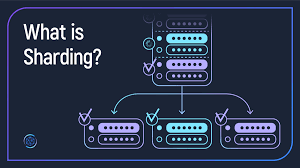 Sharding is a database partitioning technique that will be used to dramatically scale Ethereum’s blockchain and enable it to process more transactions per second.
Sharding is a database partitioning technique that will be used to dramatically scale Ethereum’s blockchain and enable it to process more transactions per second.
What is sharding?
Sharding involves a process of database portioning. The blockchain network comprises a database with nodes. When we apply sharding to the blockchain network, it split the blockchain network into individual shards/portioning. Each node should only run on the part of that shard /portioning / ledger which is assigned to the node to execute the transaction and validate the transaction. Instead of verifying every transaction on the blockchain network
Why Sharding?
On the blockchain network, every node has to compute every transaction; this takes time to execute transactions which is not an ideal situation for sustainable blockchain adoption in the long run.
For instance, Ethereum can process up to 30 transactions per second as compared to Visa which has the potential to perform 24000 transactions per second.
The adaptability of blockchain projects will enhance when it processes more and fast transactions. With sharding, nodes are assigned to compute specified operations rather than process every single operation; it improves transaction performance & allows for multiple, parallel transaction execution at the same time and overcome the scalability issue.
The intention of breaking up the blockchain network into shards is to better manage shards and to improve output efficiency of the transaction that provides a potential solution to the issue of the blockchain’s scalability.
What is the Importance of sharding?
The provided below promising features of sharding could contribute to highlight the importance of sharding:
Increase Performance:
Individual shards associate to the specified nodes to perform certain computations; it will increase the performance of the network.
Ensures reliability and sustainability:
Sharding contributes to reduce overload burden on the network, thus, increase reliability and sustainability.
Accelerate speed:
Sharding supports low computing power to verify the block, this would improve performance and transaction speed on the network.
what is sharding doing to the ecosystem? Is sharding the next big thing?
Sharding has the potential to make blockchain more efficient and scalable by segmenting large amounts of data into smaller chunks or shards.
Public blockchains are victimized of permanently storing millions of blocks on-chain, witnessing data overload causing threats for the future performance, and system efficiency of the network.
For instance, in 2017, with increased transaction activity on CryptoKitties game, clogged up the Ethereum Network, reducing transaction speed which is not an ideal situation for the adaptability of blockchain.
Sharding can solve blockchain bloat due to storing a huge number of blocks on the chain. With partitioning large databases into smaller chunks/shards and store them on individual segments. This split the network load across many nodes. Consequently, it will solve the scalability issue & increase the speed of the transaction.
Partitioning split the network into smaller groups, and processes parallel transactions which would ultimately improve transaction performance rate/ transaction per second (TPS) performance.
Sharding is doing the best for the blockchain ecosystem by accelerating the performance and efficiency of the network. When the number of clients increases, the more shards can process more transactions while using less storage, require sustainable blockchain adoption and adaptation.
Recently, sharding has gained much attention from blockchain projects supporting due to its promising attributes as scalability, sustainability, reliability, speed, and performance. Even developers of Facebook’s Libra coin describing details about Libra coin has shown their intention to implement blockchain partitioning in the future.
Who are the top companies using sharding?
The benefits of acquiring using sharding can be outsized. We are listed below some of the blockchain projects that have implemented a sharding mechanism:
Zilliqa, is identified as the first public blockchain plate form that implemented a sharding. With sharding technology, Zilliqa could able to process 2828 TPS in its test net.
Elrond is experimenting with the sharding mechanism. Elrond implementing sharding on different levels including network communication level that contribute to reducing communication overhead; transaction computation level, portioning the network into smaller groups & process parallel transaction which improves transactions per second TPS rate, and state-storage; limit the storage capacity as required, reducing storage burden on the network.
Cardino is thriving to introduce sharding tech on its blockchain through Hydra to bring the latest scalability innovation.
Ethereum Foundation is planning to implement sharding technology as part of Ethereum 2.0 to enhance scalability.
Other Blockchain projects which are working to implement sharding tech are Polkadot, NEAR, PChain, and Apollo to resolve the scalability issue.
References:
https://cointelegraph.com/explained/sharding-explained
https://www.inc.com/kenny-kline/this-database-method-is-possibly-key-to-future-of-blockchain.html
https://medium.com/@AxelUnlimited/what-is-sharding-and-why-does-it-matter-2b4710ef6a7e
https://www.zilliqa.com/platform
https://www.youtube.com/watch?v=izspfej05lE&feature=youtu.be&t=2646
Researched & Written By F. Roberts, CNIR Staff


